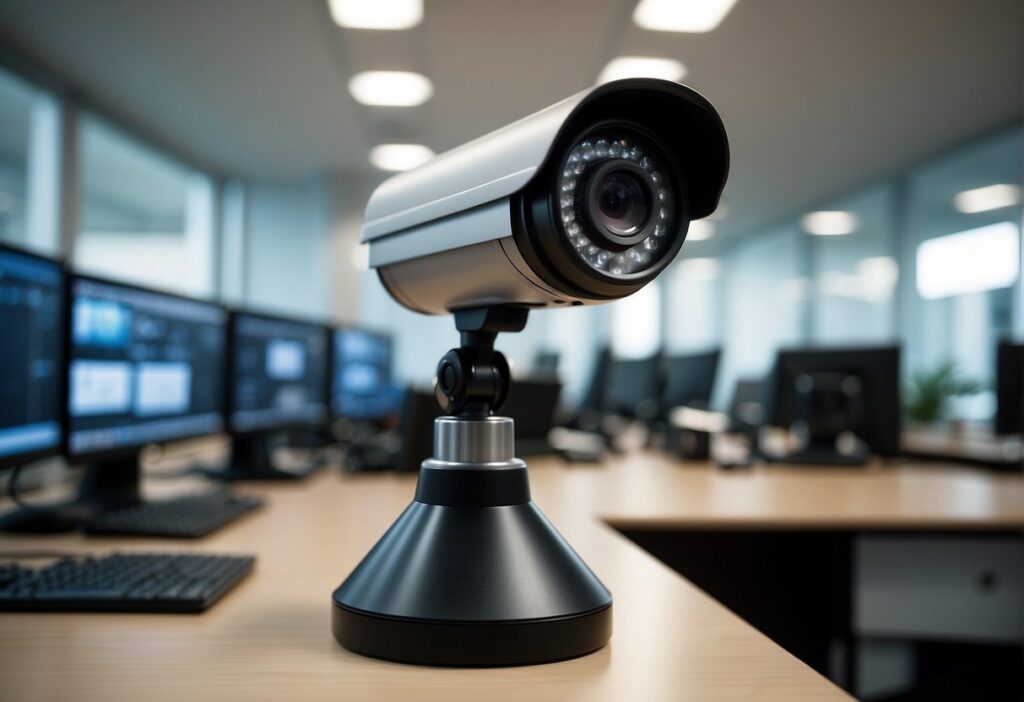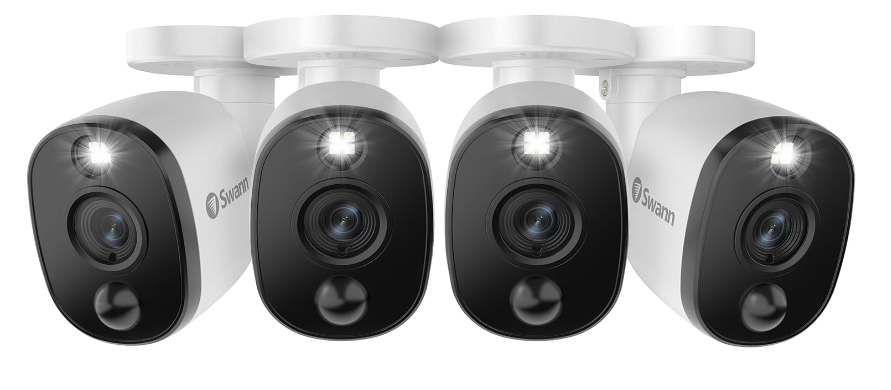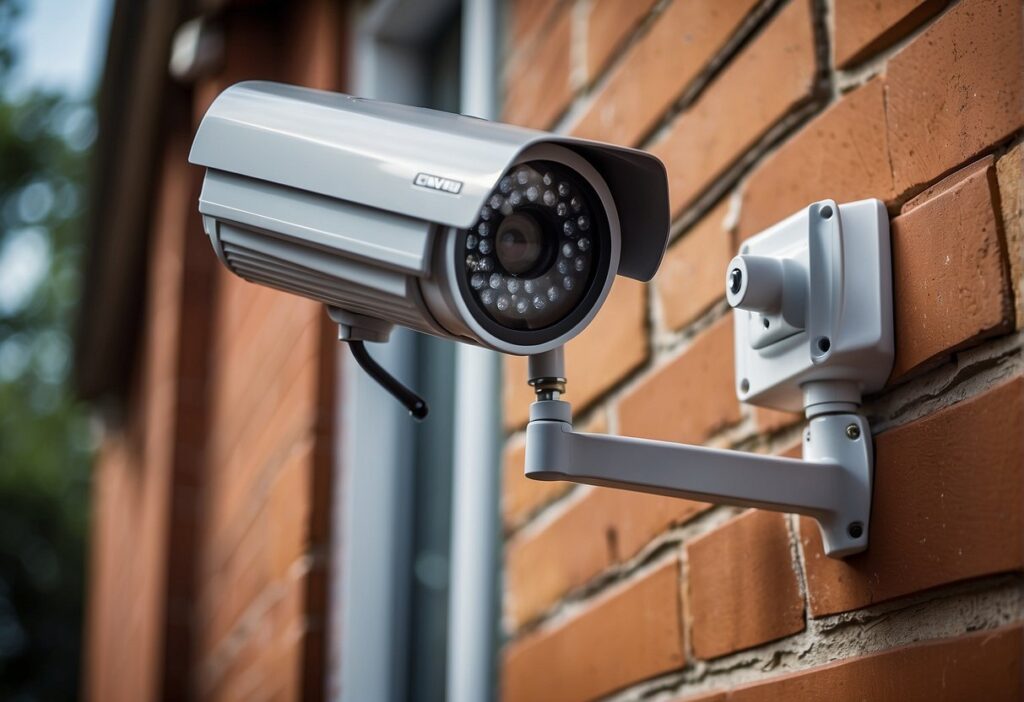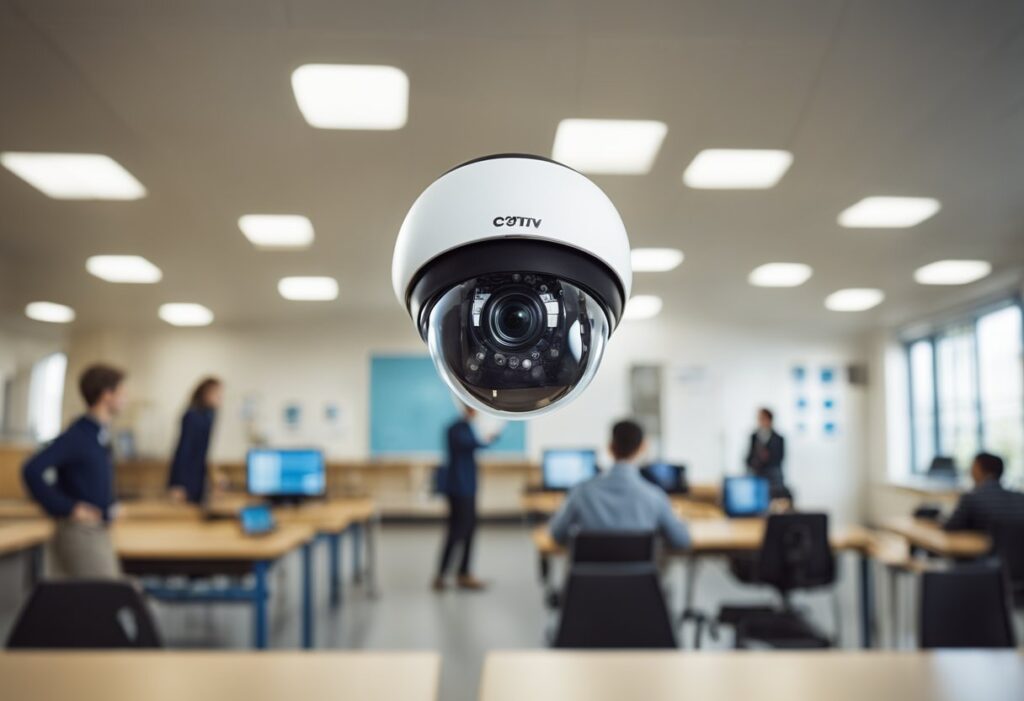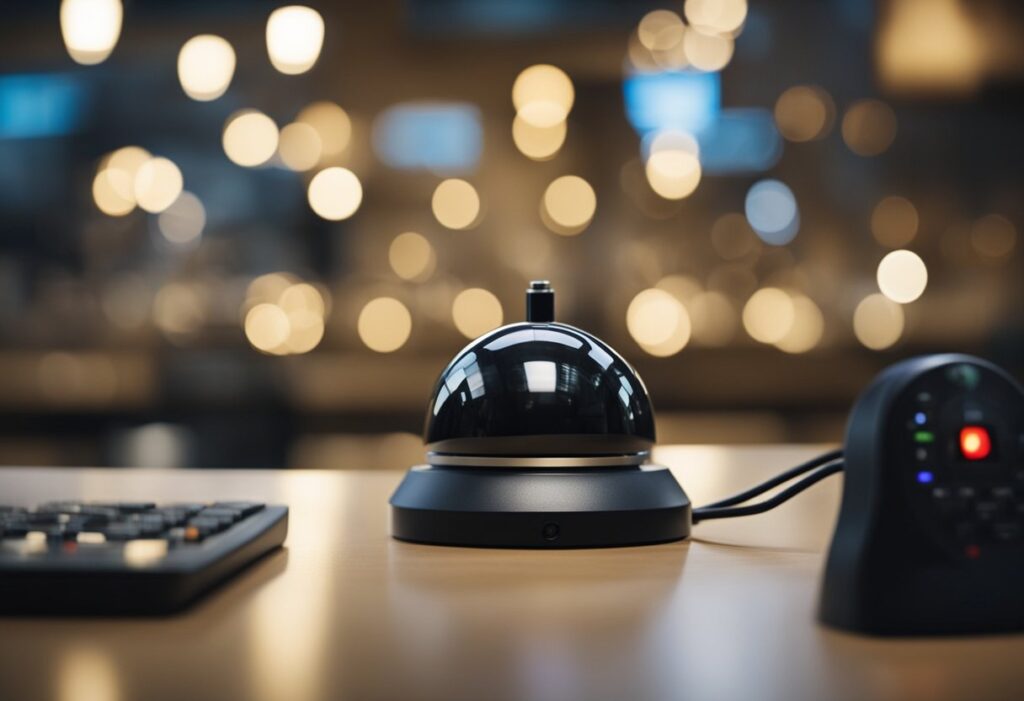(Purchases through our site links may earn us affiliate commissions)
CCTV in Office
In the professional setting, the presence of CCTV systems has become increasingly commonplace, finding its role in enhancing security and monitoring activities within the office environment. They serve as a vital tool in deterring potential theft, ensuring employee adherence to company policies, and providing evidence in the case of disputes or incidents.
Equipping an office with surveillance technology comes with its set of complexities, ranging from selecting the appropriate camera features and capabilities to navigating the legal and ethical considerations involved. Moreover, the integration of these systems with other security measures needs careful planning to ensure effectiveness and compliance with regulations.
Key Takeaways
- CCTV systems play a pivotal role in office security and monitoring.
- Choosing the right cameras and setup involves understanding specific features and legal requirements.
CCTV in Office: Understanding CCTV Technology
Closed-Circuit Television (CCTV) plays a pivotal role in the safety measures of modern office environments. It provides a continuous recording mechanism, often comprising various security cameras designed to capture and monitor live footage.
CCTV and Security Camera Systems
CCTV systems serve as security force multipliers, allowing for extensive surveillance capabilities that would be impractical with security personnel alone. These systems can be customized with a mix of indoor and outdoor cameras, depending on the specific security needs of an office.
Indoor Vs. Outdoor Surveillance Cameras
Indoor cameras often require different specifications than outdoor cameras, which must withstand environmental factors such as weather. Outdoor cameras are typically more robust and come with features like waterproofing and more durable casings to ensure continued operation in varying conditions.
Indoor cameras may afford more flexibility with design and can be less conspicuous.
Resolution and Video Quality: From 1080p HD to 4K Ultra HD
- Swan security has safeguarded homes for 35 years
- Ultra HD 4K DVR with 8 channel 4 camera
- Detect heat & Motion to reduce false triggers
- Compatible with Alexa and Google Assistant
- 2-year warranty with outstanding customer support
Resolution is a critical factor for capturing clear video footage, with options ranging from 1080p HD to 4K Ultra HD. Higher resolution cameras, such as 4K Ultra HD, offer superior detail, important for identifying individuals or activities.
As resolution increases, so does the necessity for more storage space to save the high-quality footage.
Installation and Setup
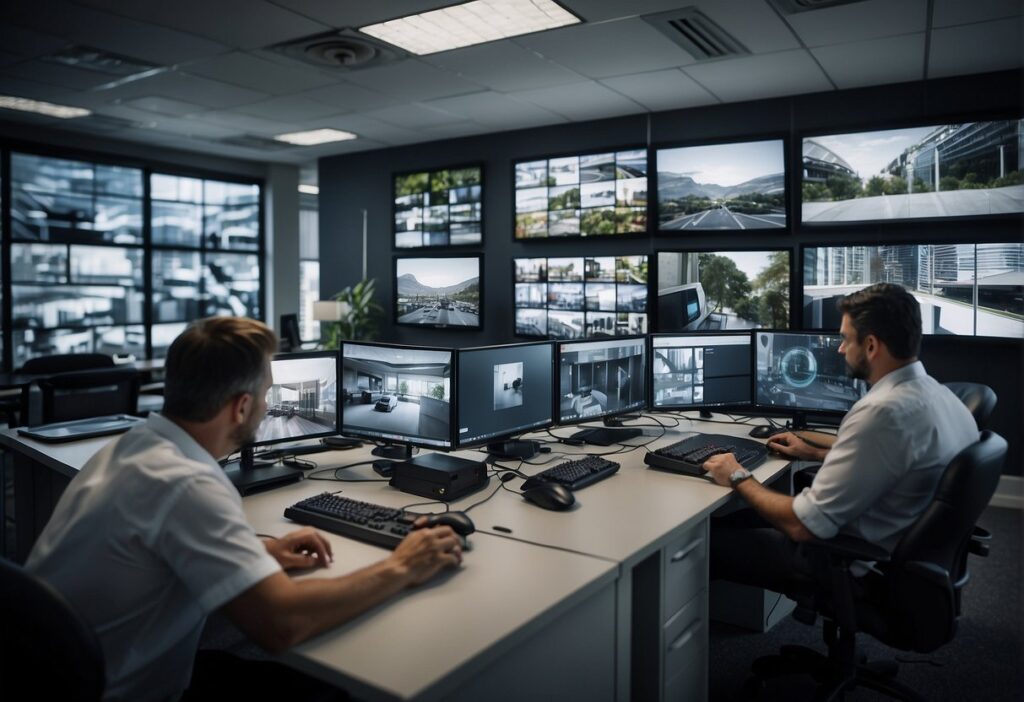
Choosing the right installation method for CCTV systems is crucial, especially considering factors like cost, complexity, and the needs of a small business.
DIY Vs. Professional Installation
Self-installation of CCTV systems can be a cost-effective solution for small businesses that have a basic understanding of networking and technology. However, they might encounter challenges that require troubleshooting skills.
For more comprehensive setups or businesses that prioritize robust security, a professional installation ensures system reliability and can often include ongoing support and maintenance.
Easy-to-Install Systems for Small Businesses
Small businesses often benefit from CCTV systems designed for easy installation. These systems usually come with user-friendly manuals and can often be monitored remotely through mobile apps.
By opting for these systems, businesses can save on installation costs and minimize downtime during setup.
Camera Features and Capabilities
Selecting the right CCTV system for an office requires understanding the various camera features and capabilities that ensure comprehensive surveillance.
Night Vision and Infrared LEDs
Night vision is a pivotal feature for CCTV systems to record in low light conditions within office environments. Cameras equipped with infrared LEDs enhance visibility in the dark, with some models offering color night vision, providing clearer and more distinguishable footage.
Motion Detection and Alerts
Office security cameras utilizing motion detection technology trigger recordings and send out alerts when movement is detected. Configurable motion sensors can differentiate between routine movements and potential security threats, initiating push notifications to inform concerned personnel promptly.
Weatherproof and Vandal-Resistant Design
- Amcrest brings more than 10 years of security camera expertise to deliver a top-notch surveillance system
- IP67 metal weatherproof & IK10 Vandal Resistant Dome
- Ultra HD 4K (8-Megapixel / 3840x2160) resolution camera
- Built-in IR LEDs & Sony Starvis 1/2.5” 8MP progressive image sensor
- Secure cloud video backup to Amazon AWS
Durability is critical for cameras placed in outdoor or semi-outdoor areas. Weatherproof cameras offer resilience to various environmental conditions, whereas vandal-resistant designs protect against tampering or damage, ensuring continuous operation and reliability of surveillance.
Connectivity and Integration
Efficient integration of CCTV in an office environment hinges on seamless connectivity. A well-designed security network ensures both flexibility and compatibility with various devices and platforms.
CCTV in Office: Wireless Security Cameras and NVR Systems
Wireless security cameras offer flexibility in installation and can reduce the clutter of cables. They transmit video to a Network Video Recorder (NVR), allowing for easy storage and retrieval of footage. The implementation of a wireless system should prioritize secure connections to prevent unauthorized access.
Smart Home Compatibility: Alexa, Google Assistant, and More
Integration with smart home assistants like Alexa and Google Assistant can enhance an office’s CCTV system. This compatibility allows for voice-activated commands and the ability to view live footage or recorded videos through connected devices.
Some systems are also compatible with Apple HomeKit, further expanding the interoperability of security devices within a smart office ecosystem.
CCTV in Office: Legal and Ethical Considerations
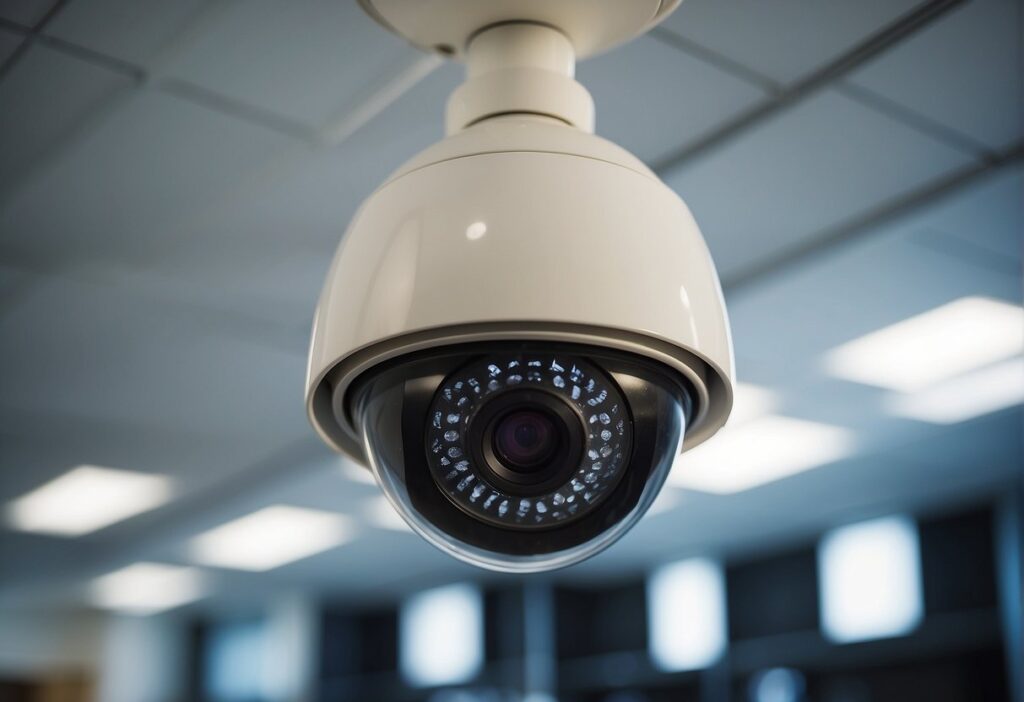
Understanding the legal and ethical implications of installing CCTV cameras in offices is crucial for any organization. Employers are tasked with the responsibility of maintaining security while upholding the privacy rights of their employees.
Privacy Rights and Surveillance Law
In the United States, privacy rights are a significant consideration when implementing workplace surveillance. These rights are often defined by a combination of federal and state laws.
For instance, certain states require employers to notify their employees about the presence of security cameras, and surveillance must be conducted in a manner consistent with legal standards.
As noted in one Ohio state code rule, surveillance should be “professional, ethical and legal”. Employers must also respect areas where there is a reasonable expectation of privacy, such as restrooms or locker rooms.
Balancing Security with Employee Privacy
Employers also need to ensure that the productivity benefits of monitoring do not infringe upon the individual privacy rights of employees. This balance is critical, as over-surveillance can lead to a decrease in employee morale and trust, potentially impacting productivity negatively.
Consequently, companies often establish clear policies that define the scope and purpose of surveillance to mitigate any adverse effects while enhancing workplace monitoring ethics.
Conclusion
CCTV in Office
CCTV systems serve as a pivotal component in maintaining a secure work environment. They act as a deterrent against misconduct, enhance the sense of security among employees, and provide valuable evidence when needed. The presence of CCTV can also be a vital tool in curbing workplace harassment, as it promotes accountability and can assist in investigations.
Regular risk assessments help to identify areas where security can be strengthened. By upgrading to advanced CCTV technology, companies can address potential vulnerabilities effectively. It’s important for businesses to stay informed about best practices for monitoring employees, ensuring that CCTV use complies with legal requirements to respect privacy rights.
Investment in CCTV not only safeguards against external threats but can also boost employee productivity by creating a safer and more focused workplace. However, it’s crucial that the implementation of these systems is accompanied by transparent communication with employees about their use and purpose. As surveillance technology continues to evolve, organizations must adapt their security strategies to protect their assets, personnel, and business interests.
